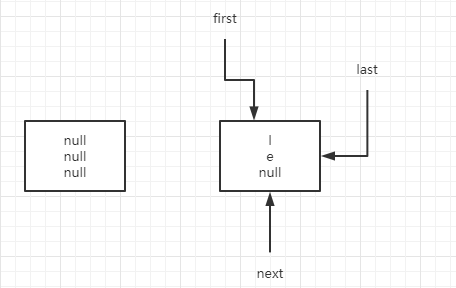1. LinkedList介绍
LinkedList是一个继承于AbstractSequentiaList的双向链表,可以被当作堆栈,队列或双端队列进行操作,它实现了List接口,也实现了java.io.Serializable接口,可以支持序列化,能够通过序列化传输。
2. LinkedList数据结构
LinkedList继承关系
public class LinkedList<E> extends AbstractSequentialList<E> implements List<E>, Deque<E>, Cloneable, java.io.Serializable
3. LinkedList源码解析
public class LinkedList<E> extends AbstractSequentialList<E> implements List<E>, Deque<E>, Cloneable, java.io.Serializable { transient int size = 0; /** * Pointer to first node. */ transient Node<E> first; /** * Pointer to last node. */ transient Node<E> last; /* void dataStructureInvariants() { assert (size == 0) ? (first == null && last == null) : (first.prev == null && last.next == null); } */ /** * Constructs an empty list. */ public LinkedList() { } /** * Constructs a list containing the elements of the specified * collection, in the order they are returned by the collection's * iterator. * * @param c the collection whose elements are to be placed into this list * @throws NullPointerException if the specified collection is null */ public LinkedList(Collection<? extends E> c) { this(); addAll(c); }
LinkedList类中定义了3个变量
size:集合长度
first:双向链表头节点
last:双向链表尾节点
first和last是Node类型,Node是一个静态内部类
private static class Node<E> { E item; Node<E> next; Node<E> prev; Node(Node<E> prev, E element, Node<E> next) { this.item = element; this.next = next; this.prev = prev; } }
LinkedList是通过双向链表实现,双链表是通过Node类实现的,类中item变量保存当前节点的值,通过Next指向下一个节点,通过prev指向前一个节点。
get()
public E get(int index) { checkElementIndex(index); return node(index).item; } /** * Returns the (non-null) Node at the specified element index. */ Node<E> node(int index) { // assert isElementIndex(index); if (index < (size >> 1)) { Node<E> x = first; for (int i = 0; i < index; i++) x = x.next; return x; } else { Node<E> x = last; for (int i = size - 1; i > index; i--) x = x.prev; return x; } }
LinkedList中get()方法的实现:是通过node(index)来实现的,它的实现机制是:比较index和集合长度一半的大小,如果index比集合长度一半小,那么就从初始位置依次循环,直到找到为止;如果index大于集合长度一半,那么就从集合末尾依次向前找,直到找到为止;也就是越靠近中间的元素,查找次数越多,效率越低。
add()
public boolean add(E e) { linkLast(e); return true; } void linkLast(E e) { final Node<E> l = last; //初始时,last为空 final Node<E> newNode = new Node<>(l, e, null); last = newNode; if (l == null) first = newNode; else l.next = newNode; size++; modCount++; }
(1)当第一个对象add时,初始时last为空赋值给l,这样newNode的prev,和next都为空,然后让last指向newNode,first指向newNode;

(2)在第二个对象add时,add()方法默认在链表的尾部添加,再次调用linkLast()方法,此时last已经不为空(last开始指向上一个结点)赋值给l,,新的节点的newNode的prev指向上一个节点,next指向null,然后让上一个结点的next指向新的节点维护双向链表。

remove()
public E remove() { return removeFirst(); } public E removeFirst() { final Node<E> f = first; if (f == null) throw new NoSuchElementException(); return unlinkFirst(f); } private E unlinkFirst(Node<E> f) { // assert f == first && f != null; final E element = f.item; final Node<E> next = f.next; f.item = null; f.next = null; // help GC first = next; if (next == null) last = null; else next.prev = null; size--; modCount++; return element; }
remove()默认删除链表的第一个结点
(1)在removeFirst()中先让first指向第一个结点;
(2)获取到第一个结点的item,获取到第二个结点(next = f.next),然后将第一个结点的item置为null,第一个结点的next指向为null,让first指向第二个结点(next),第二个结点的prev也指向为null,维护链表的关系;

4. LinkedList遍历
public class LinkedList01 { public static void main(String[] args) { LinkedList<Integer> list = getLinkedList(); listByNormalGet(list); listByForEach(list); listByInterator(list); } /* 通过迭代器遍历 */ private static void listByInterator(LinkedList<Integer> list) { long startTime = System.currentTimeMillis(); for(Iterator it = list.iterator(); it.hasNext(); ){ it.next(); } long interval = System.currentTimeMillis() - startTime; System.out.println("通过迭代器遍历:" + interval + "ms"); } /* 通过增强for遍历 */ private static void listByForEach(LinkedList<Integer> list) { long startTime = System.currentTimeMillis(); for(Integer i : list){ } long interval = System.currentTimeMillis() - startTime; System.out.println("通过增强for遍历:" + interval + "ms"); } /* 通过get遍历 */ private static void listByNormalGet(LinkedList<Integer> list) { long startTime = System.currentTimeMillis(); for (int i = 0; i < list.size(); i++) { list.get(i); } long interval = System.currentTimeMillis() - startTime; System.out.println("通过get遍历:" + interval + "ms"); } /* 创建一个LinedList */ private static LinkedList<Integer> getLinkedList() { LinkedList list = new LinkedList(); for (int i = 0; i < 50000; i++) { list.add(i); } return list; } }
通过迭代器和增强for的遍历方式时间远远小于通过get方式遍历,通过反编译工具查看通过增强for循环也是调用迭代器iterator。